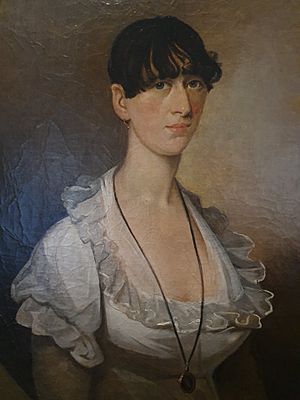Mary Anne Holmes facts for kids
Quick facts for kids
Mary Anne Holmes
|
|
|---|---|

Portrait of Holmes by Thomas Hickey
|
|
| Born |
Mary Anne Emmet
10 October 1773 Dublin, Ireland
|
| Died | 10 March 1805 (aged 31) |
| Nationality | Irish |
| Known for | poetry |
Mary Anne Holmes (born Emmet) (10 October 1773 – 10 March 1805) was an Irish poet and writer. She was connected to the United Irishmen through her brothers, Thomas Addis Emmet and Robert Emmet. The United Irishmen were a group who wanted Ireland to be independent.
Contents
Mary Anne Holmes's Life
Mary Anne Emmet was born in Dublin, Ireland, on October 10, 1773. She was one of four children who survived from her parents, Dr. Robert Emmet and Elizabeth Emmet. Her father was a well-known doctor in Ireland.
Her Early Years and Interests
As a young woman, Mary Anne was very smart. She studied classical subjects, like ancient Greek and Roman history. Her father was proud of her good character. She was interested in politics, just like her brothers. She was part of a group of thinkers who had liberal ideas. She also wrote letters to Margaret King, sharing their love for the writings of Mary Wollstonecraft. Mary Wollstonecraft was a famous writer who believed in equal rights for women.
Marriage and Family Life
In 1793, a family friend named William Drennan described Mary Anne as polite but a bit distant. He thought she would marry a lawyer named Robert Holmes. Mary Anne and Robert Holmes secretly married on September 21, 1799. They had at least four children together.
Robert Holmes helped with the legal matters for Mary Anne's family. Mary Anne and Robert lived with her parents for a while. Mary Anne also helped raise the children of her brother, Thomas Addis. This was when Thomas Addis was sent away for his involvement with the United Irishmen. Her mother's letters showed that Mary Anne was devoted to her husband. However, she often had delicate health and felt sad sometimes.
Family Challenges and Later Life
Mary Anne was the only one of her 17 siblings who was still living in Ireland. She was a great comfort to her parents as they grew older. Her father passed away in 1802. Her mother became very ill in 1803, around the same time her brother Robert was arrested and executed. Some stories say that Mary Anne tried to get her brother's body back, but she could not.
After an unsuccessful rebellion in 1803, her husband was arrested. Mary Anne was allowed to stay with him for about a week. It was once believed that she died right after his release in 1804. But she actually gave birth to a son at home. After this, her health got worse, and her hearing also became poor. Her son, Hugh, also died later.
Mary Anne was cared for by Dr. Drennan, who worried she had a serious illness in December. Mary Anne Holmes died on March 10, 1805. She was buried with her parents in the graveyard of St. Peter's Church, Aungier Street, Dublin. There is a legend that her brother Robert's body was secretly buried with her, but this is not confirmed. A painting of Mary Anne Holmes by Thomas Hickey is kept at Kilmainham Gaol.
Her Writings and Poems
Mary Anne Holmes wrote both prose (like stories or articles) and poems for a newspaper called the Press. This newspaper was connected to the Society of United Irishmen. In 1799, she was active in the movement that was against Ireland joining with the United Kingdom.
A pamphlet called An address to the people of Ireland was thought to be written by her. However, it is now believed that Roger O'Connor wrote it. Mary Anne's poems were later included in a book of poems published by her daughter in 1833. The book was called The dream and other poems.

